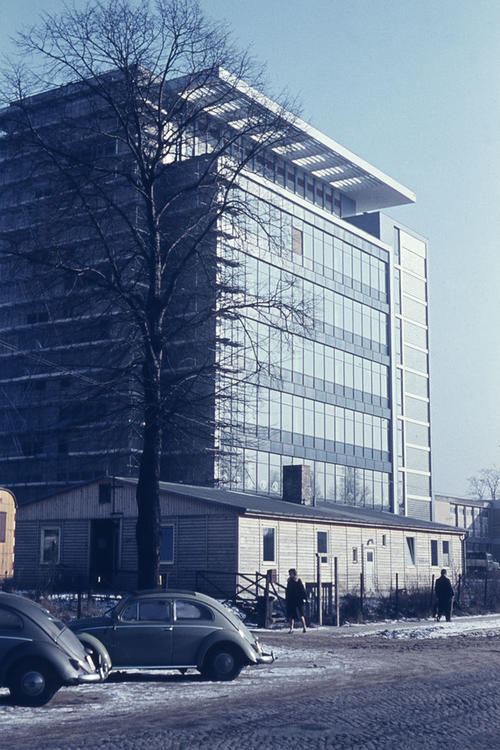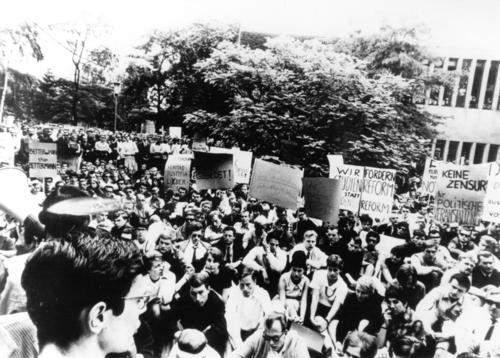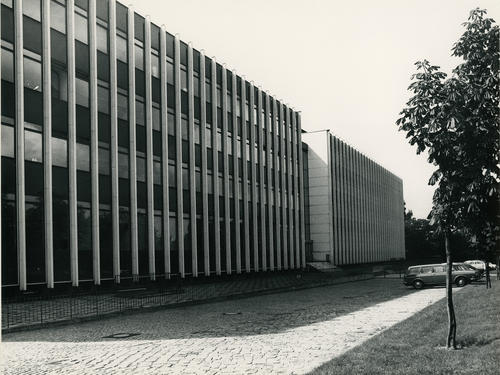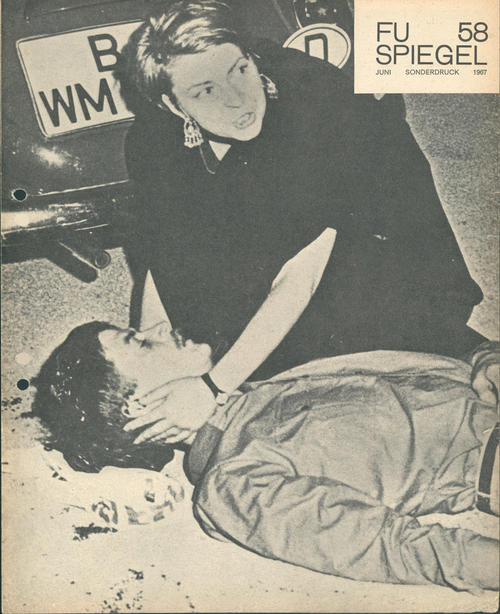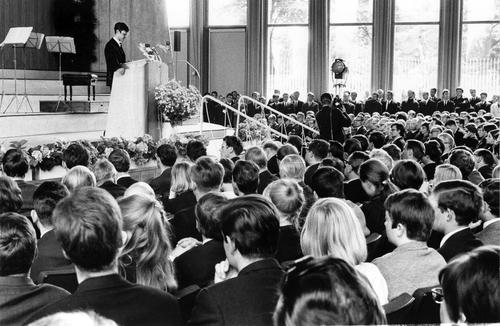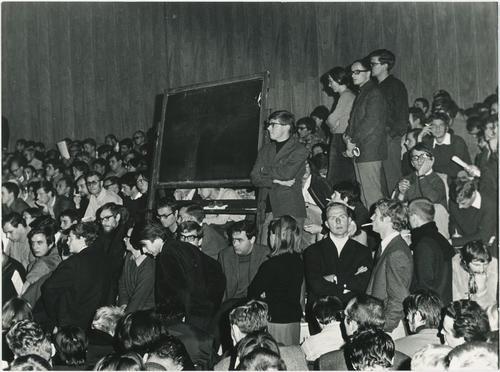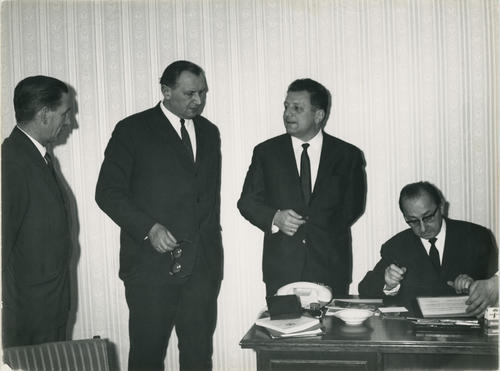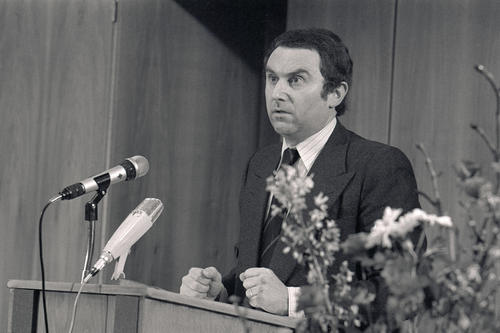The 1960s
Spring in 1961
The Institute of Physical Chemistry
Image Credit: Reinhard Friedrich / Universitätsarchiv der Freien Universität
The Institute of Physical Chemistry was founded in the spring of 1961. Initially it was housed in the Otto-Hahn Building (which was renamed the Hahn-Meitner Building in October 2010) at Thiel Allee 63-67 (see photo). In 1978 the Institute of Physical Chemistry was moved to Taku Strasse 3. Today it is called the Physical and Theoretical Chemistry Division in the Institute of Chemistry and Biochemistry.
August 13, 1961
August 13, 1961: Construction of the Berlin Wall began.
Image Credit: Reinhard Friedrich / Universitätsarchiv der Freien Universität
Construction of the Berlin Wall began. More than 3,500 students who commuted regularly from East Berlin and the GDR were suddenly cut off from their education in Dahlem. Detlef Girrmann, Dieter Thieme, Bodo Köhler, and Burkhart Veigel, all students at Freie Universität, immediately began to organize escape operations, in which several hundred fellow students took part until 1963. The GDR state security managed to infiltrate the network, and by the end of 1963, more than 70 students were arrested and convicted for helping others escape.
May 1963
The Institute of Inorganic Chemistry moved to Fabeck Strasse 34/36. The building was the first one to be newly constructed for the Faculty of Mathematics and Natural Sciences. It was designed by Hans Geber and Otto Risse, the same architects who were also responsible for the new buildings of the Faculty of Economics and Social Sciences (1958) at Gary Strasse 21 and the Faculty of Law (1959) at Van’t Hoff Strasse 8.
June 26, 1963
United States President John F. Kennedy at Freie Universität Berlin
Image Credit: Freie Universität Berlin / Universitätsarchiv / Joachim C. Jung
World politics in Dahlem: The President of the United States John F. Kennedy was made an honorary citizen of Freie Universität Berlin and spoke to around 20,000 people at the Henry Ford Building. He said, “This school (...) must be interested in turning out citizens of the world, men who comprehend the difficult, sensitive tasks, that lie before us as free men and women, and men who are willing to commit their energies to the advancement of a free society.” Kennedy was assassinated five months after his visit in Berlin. Three days later the Institute for North American Studies, which had just been founded at Freie Universität, was renamed John F. Kennedy Institute for North American Studies.
May 1965
Journalist Erich Kuby at Technische Universität Berlin
Image Credit: Reinhard Friedrich / Universitätsarchiv der Freien Universität
There were protests in support of the journalist Erich Kuby who had been banned from speaking by the university management. Kuby objected to the name “Freie Universität” or “Free University” as he said the designation was incompatible with the scholarly and educational tasks of a university because it implicitly referred to the university in the eastern part of the city as “unfree.” Political scientist Ekkehart Krippendorff criticized the university’s decision in the daily newspaper Spandau Volksblatt, and his employment contract was not extended. In the fall of 1965, the Kuby’s gag order was lifted, and Krippendorff returned to Freie Universität.
June 22, 1966
Students at a demonstration
Image Credit: Universitätsarchiv der Freien Universität / Heinz O. Jurisch
The first sit-in at a German university took place on June 22 at Freie Universität in protest against the expulsion of long-term students from the Faculty of Law. Three thousand young people occupied the Henry Ford Building. After they ended the strike during the night, Knut Nevermann, the president of the student union (AStA), read a resolution. The picture shows Nevermann at a different demonstration during the same month.
April 1, 1967
Building at Koser Strasse 20
Image Credit: Reinhard Friedrich / Universitätsarchiv der Freien Universität
A new building for the veterinary preclinical subjects was opened at Koser Strasse 20. The architects were Wassili Luckhardt and Hans-Joachim Wandelt. Since 1998 the Friedrich Meinecke Institute for History (FMI) and the Art History Institute (KHI) have been located there as well as the Center for Comparative History of Europe (since 2004: Berlin School for Comparative European History). The Institute of Veterinary Anatomy is still located there and is one of the few remaining institutes in the Department of Veterinary Medicine to remain in Dahlem. The others relocated to the main veterinary campus, which was established in Düppel in 1951.
June 2, 1967
The AstA magazine was called “FU Spiegel.”
Image Credit: Freie Universität Berlin / Universitätsarchiv / FU-Spiegel - Sonderdruck 1967
Benno Ohnesorg, a student of Romance and German languages and literatures at Freie Universität, was shot in the head by police officer Karl-Heinz Kurras during a demonstration against the visit of the Shah of Iran. In 2009 it became known that Kurras was a secret employee of the GDR Ministry for State Security and a member of the SED party. The picture shows the student Friederike Dollinger next to the seriously injured man, who later died in the ambulance. It was the title page of the AStA magazine “FU Spiegel,” which the student union had been publishing since 1955.
June 8, 1967
Memorial service for Benno Ohnesorg in the Audimax of Freie Universität
Image Credit: Universitätsarchiv der Freien Universität / Jürgen Hentschel
Memorial service for Benno Ohnesorg in the Audimax of Freie Universität. The president of AStA Knut Nevermann is at the lectern. Later, Nevermann became the head of office for the Minister of State for Culture and Media in the German federal government under Gerhard Schröder, and he was State Secretary in the Berlin Academic Administration until he retired.
November 1, 1967
The founding assembly of the “Critical University” (KU)
Image Credit: Universitätsarchiv der Freien Universität / Hellmuth Pollacezek
Around 2,000 students from universities in West Berlin gathered at the founding assembly of the “Critical University” (KU) in the Audimax of Freie Universität. The KU aimed to seek alternatives to existing society. Around 30 working groups were set up on topics such as “Sexuality and Domination,” “Psychosomatic Medicine,” “Possibilities and Problems of Political Theology,” or “Imperialism and Development Problems.”
January 26, 1968
An exchange program was set up with the University of Leningrad (today: St. Petersburg)
Image Credit: Freie Universität Berlin / Universitätsarchiv
An exchange program was set up with the University of Leningrad (today: St. Petersburg). It was the first partnership agreement between a university in the Federal Republic of Germany and West Berlin and a university in the Soviet Union. Shown signing the documents: Rector Ewald Harndt (1st at right) and his predecessor, Hans-Joachim Lieber (2nd from right). Since 2012, Freie Universität and the University of St. Petersburg have had a strategic partnership, which was put on hold in March 2022.
April 11, 1968
An assassination attempt was made on Rudi Dutschke. The sociology student was shot by a right-wing extremist on Kurfürstendamm. The photo shows Dutschke’s bicycle at the crime scene. That evening there were riots in front of the Springer high-rise in Kreuzberg. The extra-parliamentary opposition blamed the way the Springer newspapers reported on Rudi Dutschke for the assassination attempt. The protests spread nationwide and resulted in two fatalities in clashes with the police in Munich.
October 9, 1968
Klinikum Steglitz of Freie Universität
Image Credit: Reinhard Friedrich / Universitätsarchiv der Freien Universität
Klinikum Steglitz, Freie Universität’s university hospital was opened. In 1994 it was renamed Universitätsklinikum Benjamin Franklin and in 2003 Campus Benjamin Franklin, when it became part of Charité – Universitätsmedizin Berlin, the university medical school operated jointly by Freie Universität and Humboldt-Universität.
November 24, 1969
Physicist and sociologist Rolf Kreibich
Image Credit: Reinhard Friedrich / Universitätsarchiv der Freien Universität
In July 1969 the Berlin Universities Act came into force and led to the restructuring of Freie Universität. The student body, mid-level faculty, and nonacademic staff were given co-determination rights. The physicist and sociologist Rolf Kreibich was elected president. It was the first time that a research assistant headed a German university. Kreibich held this office until 1976.
1970
The Institute for Latin American Studies was opened. The interdisciplinary central institute for research and teaching in ancient American studies, history, Latin American studies, politics, sociology, and economics moved into a building at Rüdesheimer Strasse 54-56. The building was designed by Max Taut and Franz Hoffmann from 1929 to 1930 for the German Miners’ Union.



